Sociology Essay: Healthcare Access and Aboriginal Communities
VerifiedAdded on 2022/08/16
|8
|1833
|15
Essay
AI Summary
This sociology essay delves into the critical issue of healthcare access for Aboriginal Canadians, exploring the significant challenges they face. It begins by highlighting the importance of healthcare as a social determinant of health and then examines the inequalities in healthcare access experienced by this population. The essay discusses governmental policies and their effectiveness, presenting research findings from interviews and observations conducted within Aboriginal communities. It identifies key barriers, including the availability of healthcare providers, long waiting times, geographical limitations, and financial constraints. Furthermore, it analyzes the impact of education and awareness on health outcomes, emphasizing the role of discrimination and systemic issues. The essay concludes by reflecting on how the research process shaped the understanding of these complex challenges and underscores the persistent need for equity in healthcare for Aboriginal Canadians, considering factors such as the government's approach and the influence of capitalist systems. It also references relevant literature to support its arguments and highlights the significance of qualitative research methods in understanding the issue.
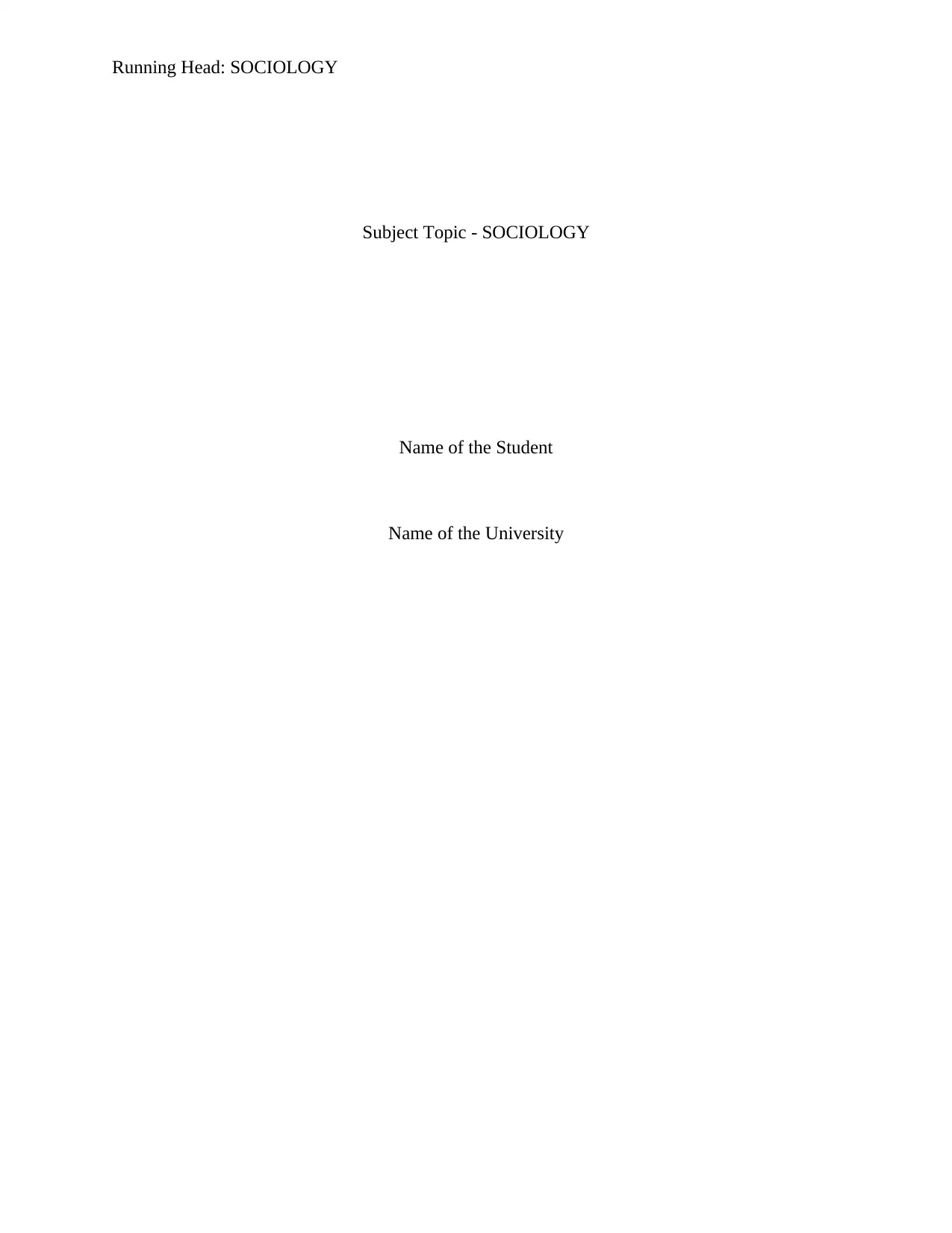
Running Head: SOCIOLOGY
Subject Topic - SOCIOLOGY
Name of the Student
Name of the University
Subject Topic - SOCIOLOGY
Name of the Student
Name of the University
Paraphrase This Document
Need a fresh take? Get an instant paraphrase of this document with our AI Paraphraser
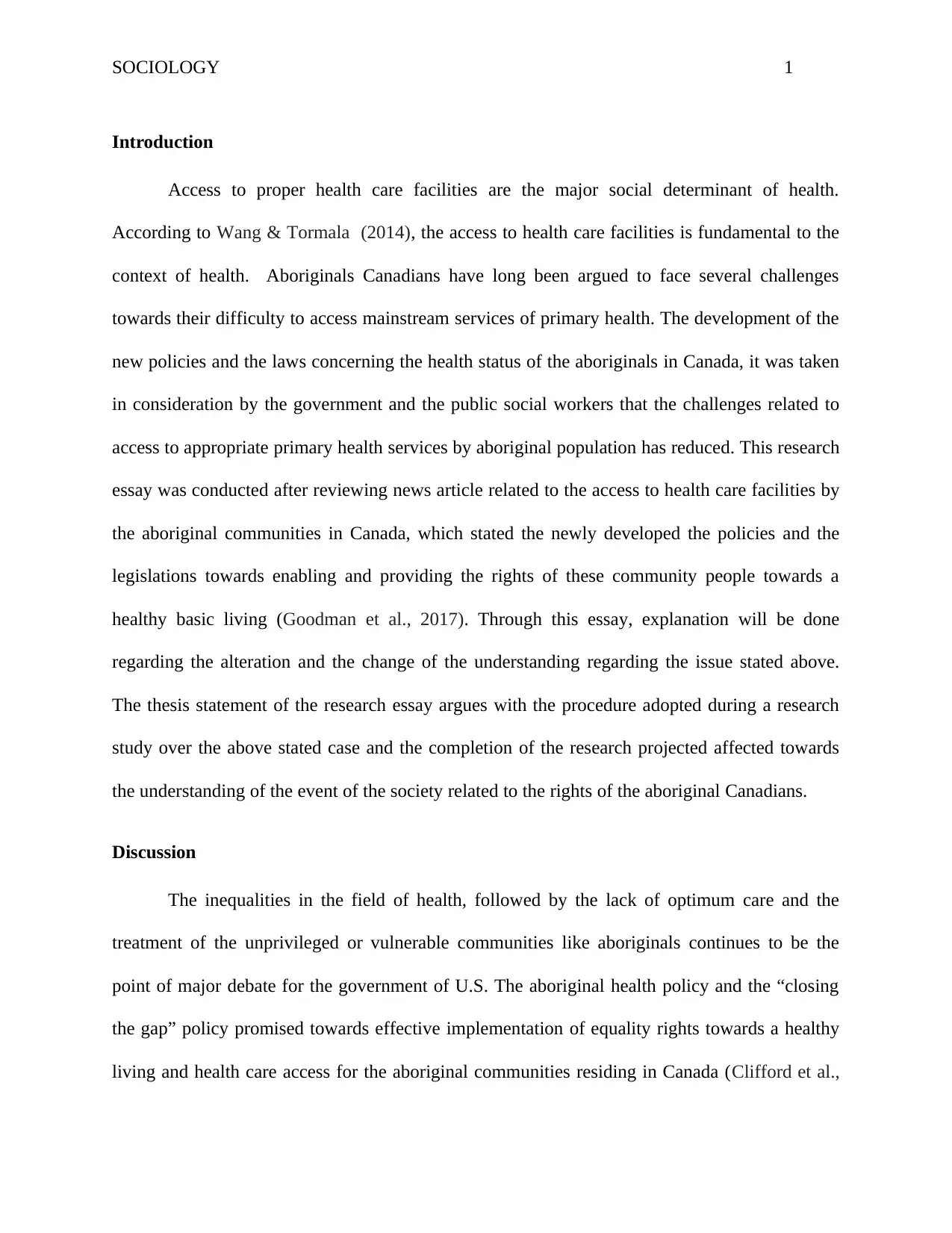
SOCIOLOGY 1
Introduction
Access to proper health care facilities are the major social determinant of health.
According to Wang & Tormala (2014), the access to health care facilities is fundamental to the
context of health. Aboriginals Canadians have long been argued to face several challenges
towards their difficulty to access mainstream services of primary health. The development of the
new policies and the laws concerning the health status of the aboriginals in Canada, it was taken
in consideration by the government and the public social workers that the challenges related to
access to appropriate primary health services by aboriginal population has reduced. This research
essay was conducted after reviewing news article related to the access to health care facilities by
the aboriginal communities in Canada, which stated the newly developed the policies and the
legislations towards enabling and providing the rights of these community people towards a
healthy basic living (Goodman et al., 2017). Through this essay, explanation will be done
regarding the alteration and the change of the understanding regarding the issue stated above.
The thesis statement of the research essay argues with the procedure adopted during a research
study over the above stated case and the completion of the research projected affected towards
the understanding of the event of the society related to the rights of the aboriginal Canadians.
Discussion
The inequalities in the field of health, followed by the lack of optimum care and the
treatment of the unprivileged or vulnerable communities like aboriginals continues to be the
point of major debate for the government of U.S. The aboriginal health policy and the “closing
the gap” policy promised towards effective implementation of equality rights towards a healthy
living and health care access for the aboriginal communities residing in Canada (Clifford et al.,
Introduction
Access to proper health care facilities are the major social determinant of health.
According to Wang & Tormala (2014), the access to health care facilities is fundamental to the
context of health. Aboriginals Canadians have long been argued to face several challenges
towards their difficulty to access mainstream services of primary health. The development of the
new policies and the laws concerning the health status of the aboriginals in Canada, it was taken
in consideration by the government and the public social workers that the challenges related to
access to appropriate primary health services by aboriginal population has reduced. This research
essay was conducted after reviewing news article related to the access to health care facilities by
the aboriginal communities in Canada, which stated the newly developed the policies and the
legislations towards enabling and providing the rights of these community people towards a
healthy basic living (Goodman et al., 2017). Through this essay, explanation will be done
regarding the alteration and the change of the understanding regarding the issue stated above.
The thesis statement of the research essay argues with the procedure adopted during a research
study over the above stated case and the completion of the research projected affected towards
the understanding of the event of the society related to the rights of the aboriginal Canadians.
Discussion
The inequalities in the field of health, followed by the lack of optimum care and the
treatment of the unprivileged or vulnerable communities like aboriginals continues to be the
point of major debate for the government of U.S. The aboriginal health policy and the “closing
the gap” policy promised towards effective implementation of equality rights towards a healthy
living and health care access for the aboriginal communities residing in Canada (Clifford et al.,
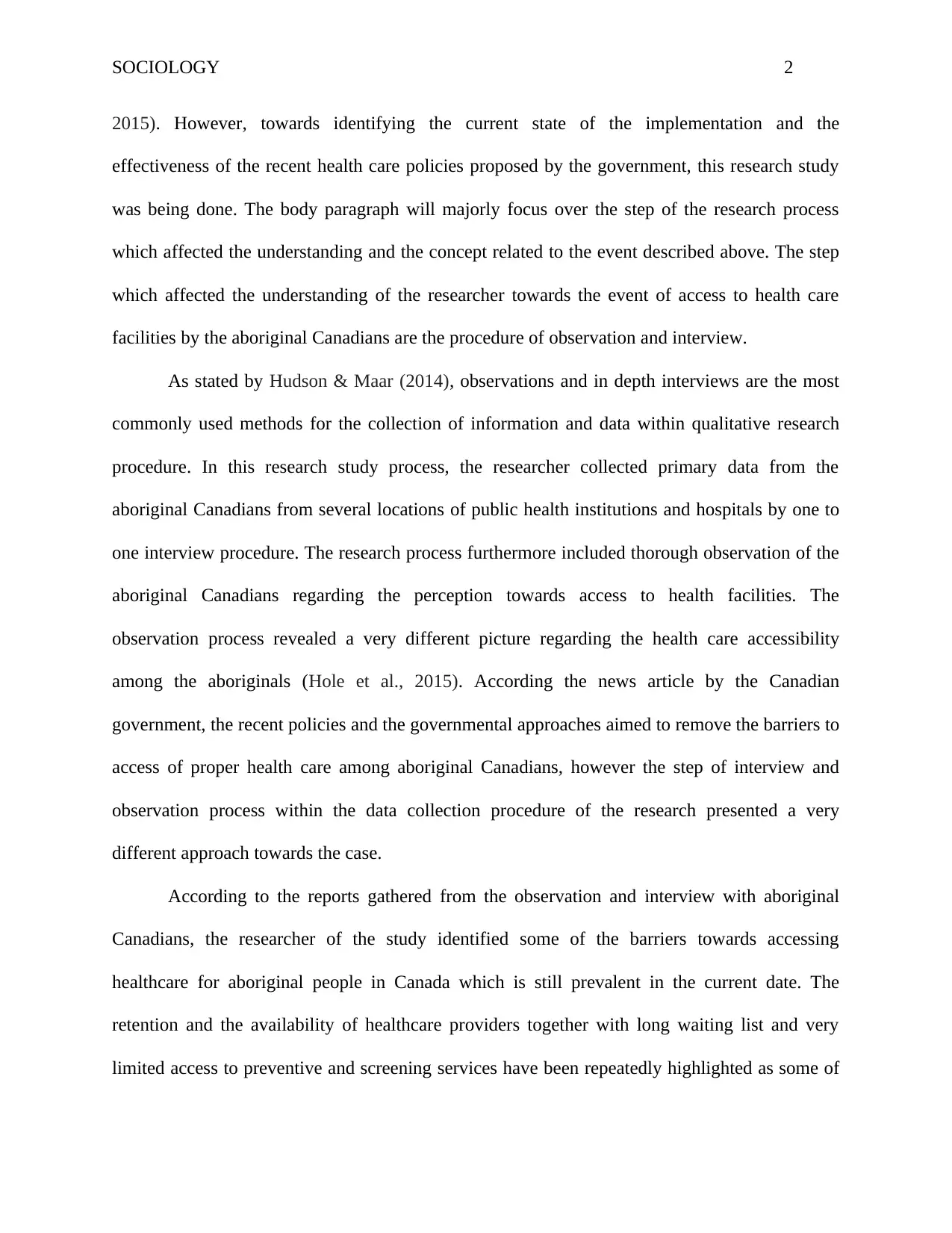
SOCIOLOGY 2
2015). However, towards identifying the current state of the implementation and the
effectiveness of the recent health care policies proposed by the government, this research study
was being done. The body paragraph will majorly focus over the step of the research process
which affected the understanding and the concept related to the event described above. The step
which affected the understanding of the researcher towards the event of access to health care
facilities by the aboriginal Canadians are the procedure of observation and interview.
As stated by Hudson & Maar (2014), observations and in depth interviews are the most
commonly used methods for the collection of information and data within qualitative research
procedure. In this research study process, the researcher collected primary data from the
aboriginal Canadians from several locations of public health institutions and hospitals by one to
one interview procedure. The research process furthermore included thorough observation of the
aboriginal Canadians regarding the perception towards access to health facilities. The
observation process revealed a very different picture regarding the health care accessibility
among the aboriginals (Hole et al., 2015). According the news article by the Canadian
government, the recent policies and the governmental approaches aimed to remove the barriers to
access of proper health care among aboriginal Canadians, however the step of interview and
observation process within the data collection procedure of the research presented a very
different approach towards the case.
According to the reports gathered from the observation and interview with aboriginal
Canadians, the researcher of the study identified some of the barriers towards accessing
healthcare for aboriginal people in Canada which is still prevalent in the current date. The
retention and the availability of healthcare providers together with long waiting list and very
limited access to preventive and screening services have been repeatedly highlighted as some of
2015). However, towards identifying the current state of the implementation and the
effectiveness of the recent health care policies proposed by the government, this research study
was being done. The body paragraph will majorly focus over the step of the research process
which affected the understanding and the concept related to the event described above. The step
which affected the understanding of the researcher towards the event of access to health care
facilities by the aboriginal Canadians are the procedure of observation and interview.
As stated by Hudson & Maar (2014), observations and in depth interviews are the most
commonly used methods for the collection of information and data within qualitative research
procedure. In this research study process, the researcher collected primary data from the
aboriginal Canadians from several locations of public health institutions and hospitals by one to
one interview procedure. The research process furthermore included thorough observation of the
aboriginal Canadians regarding the perception towards access to health facilities. The
observation process revealed a very different picture regarding the health care accessibility
among the aboriginals (Hole et al., 2015). According the news article by the Canadian
government, the recent policies and the governmental approaches aimed to remove the barriers to
access of proper health care among aboriginal Canadians, however the step of interview and
observation process within the data collection procedure of the research presented a very
different approach towards the case.
According to the reports gathered from the observation and interview with aboriginal
Canadians, the researcher of the study identified some of the barriers towards accessing
healthcare for aboriginal people in Canada which is still prevalent in the current date. The
retention and the availability of healthcare providers together with long waiting list and very
limited access to preventive and screening services have been repeatedly highlighted as some of
⊘ This is a preview!⊘
Do you want full access?
Subscribe today to unlock all pages.

Trusted by 1+ million students worldwide
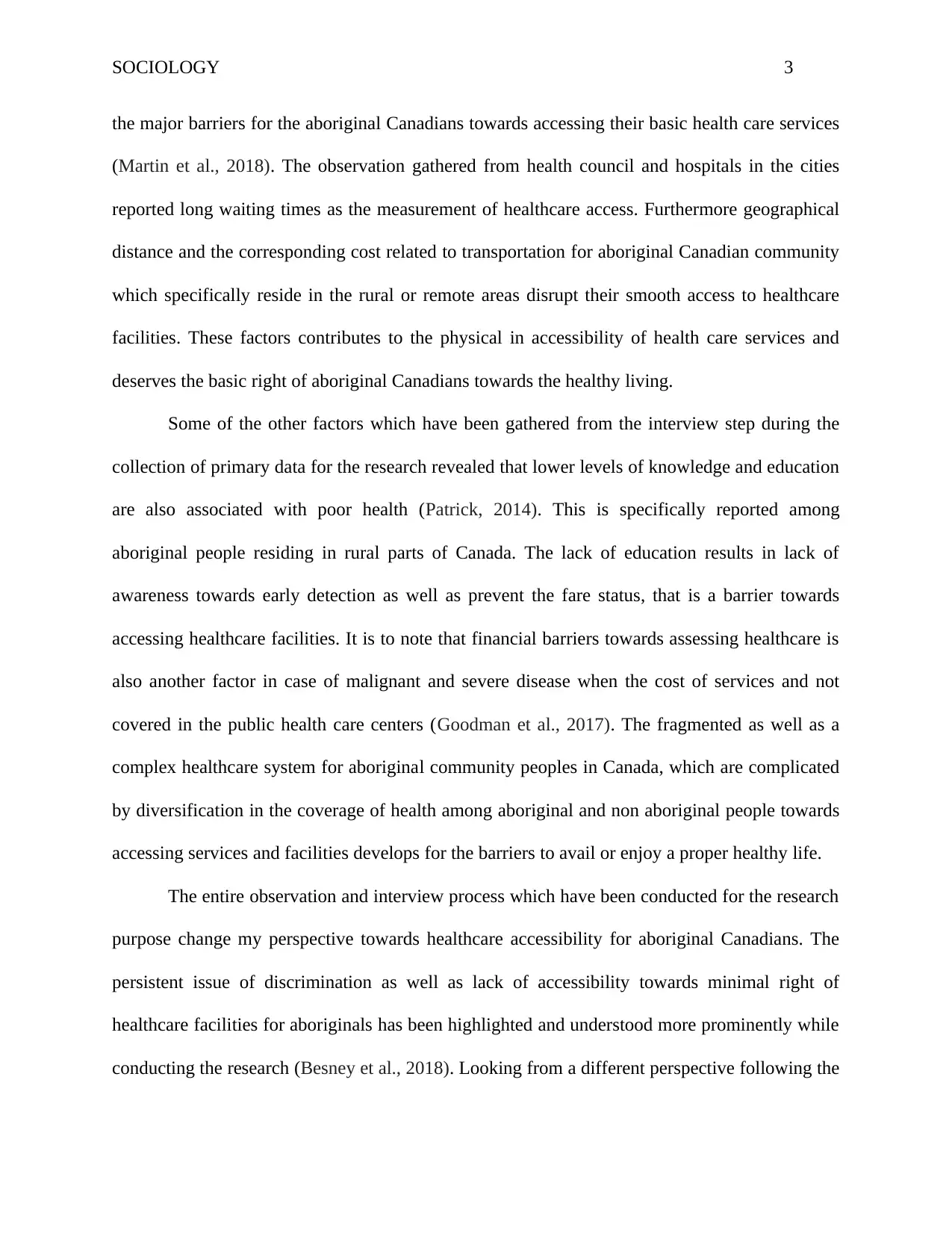
SOCIOLOGY 3
the major barriers for the aboriginal Canadians towards accessing their basic health care services
(Martin et al., 2018). The observation gathered from health council and hospitals in the cities
reported long waiting times as the measurement of healthcare access. Furthermore geographical
distance and the corresponding cost related to transportation for aboriginal Canadian community
which specifically reside in the rural or remote areas disrupt their smooth access to healthcare
facilities. These factors contributes to the physical in accessibility of health care services and
deserves the basic right of aboriginal Canadians towards the healthy living.
Some of the other factors which have been gathered from the interview step during the
collection of primary data for the research revealed that lower levels of knowledge and education
are also associated with poor health (Patrick, 2014). This is specifically reported among
aboriginal people residing in rural parts of Canada. The lack of education results in lack of
awareness towards early detection as well as prevent the fare status, that is a barrier towards
accessing healthcare facilities. It is to note that financial barriers towards assessing healthcare is
also another factor in case of malignant and severe disease when the cost of services and not
covered in the public health care centers (Goodman et al., 2017). The fragmented as well as a
complex healthcare system for aboriginal community peoples in Canada, which are complicated
by diversification in the coverage of health among aboriginal and non aboriginal people towards
accessing services and facilities develops for the barriers to avail or enjoy a proper healthy life.
The entire observation and interview process which have been conducted for the research
purpose change my perspective towards healthcare accessibility for aboriginal Canadians. The
persistent issue of discrimination as well as lack of accessibility towards minimal right of
healthcare facilities for aboriginals has been highlighted and understood more prominently while
conducting the research (Besney et al., 2018). Looking from a different perspective following the
the major barriers for the aboriginal Canadians towards accessing their basic health care services
(Martin et al., 2018). The observation gathered from health council and hospitals in the cities
reported long waiting times as the measurement of healthcare access. Furthermore geographical
distance and the corresponding cost related to transportation for aboriginal Canadian community
which specifically reside in the rural or remote areas disrupt their smooth access to healthcare
facilities. These factors contributes to the physical in accessibility of health care services and
deserves the basic right of aboriginal Canadians towards the healthy living.
Some of the other factors which have been gathered from the interview step during the
collection of primary data for the research revealed that lower levels of knowledge and education
are also associated with poor health (Patrick, 2014). This is specifically reported among
aboriginal people residing in rural parts of Canada. The lack of education results in lack of
awareness towards early detection as well as prevent the fare status, that is a barrier towards
accessing healthcare facilities. It is to note that financial barriers towards assessing healthcare is
also another factor in case of malignant and severe disease when the cost of services and not
covered in the public health care centers (Goodman et al., 2017). The fragmented as well as a
complex healthcare system for aboriginal community peoples in Canada, which are complicated
by diversification in the coverage of health among aboriginal and non aboriginal people towards
accessing services and facilities develops for the barriers to avail or enjoy a proper healthy life.
The entire observation and interview process which have been conducted for the research
purpose change my perspective towards healthcare accessibility for aboriginal Canadians. The
persistent issue of discrimination as well as lack of accessibility towards minimal right of
healthcare facilities for aboriginals has been highlighted and understood more prominently while
conducting the research (Besney et al., 2018). Looking from a different perspective following the
Paraphrase This Document
Need a fresh take? Get an instant paraphrase of this document with our AI Paraphraser
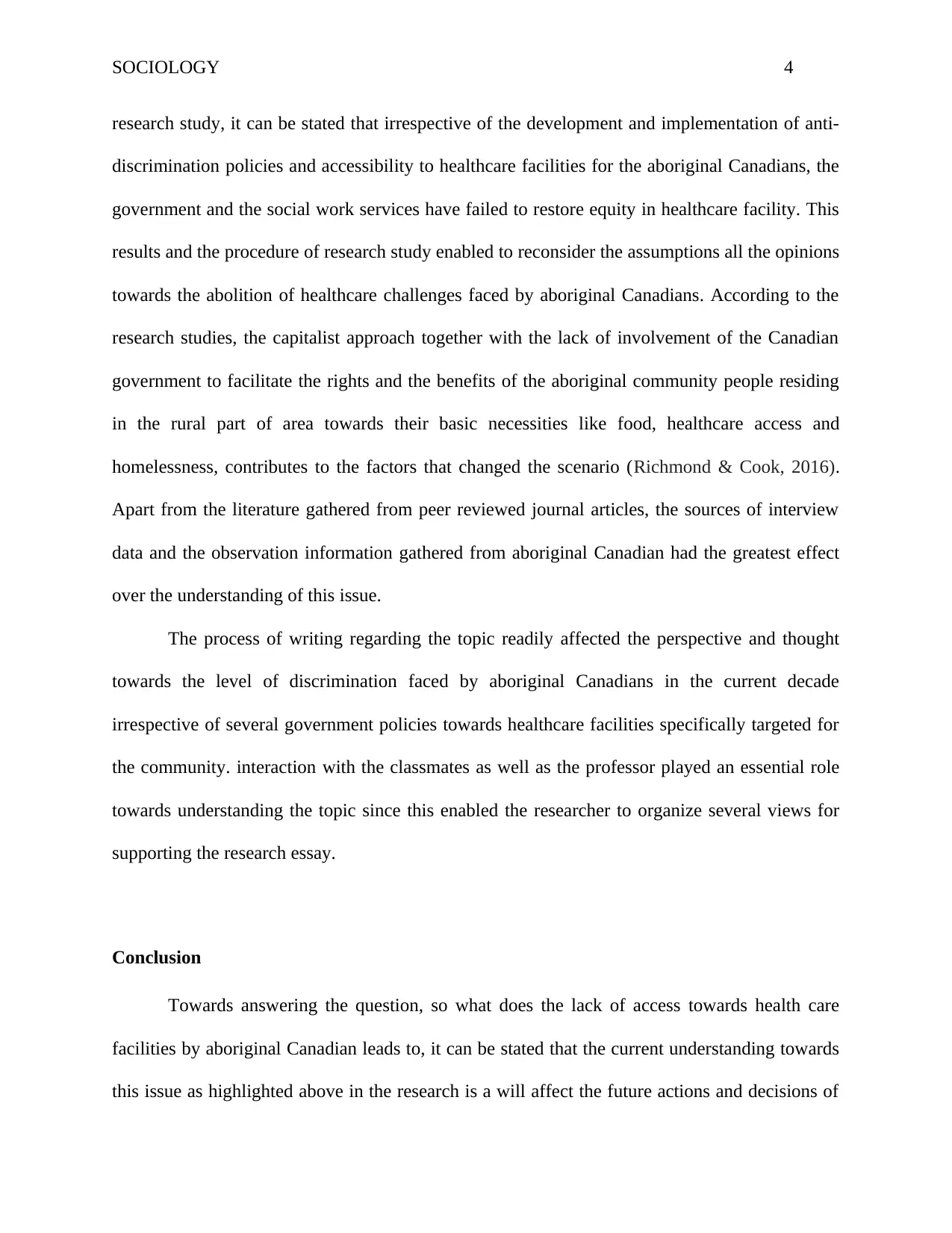
SOCIOLOGY 4
research study, it can be stated that irrespective of the development and implementation of anti-
discrimination policies and accessibility to healthcare facilities for the aboriginal Canadians, the
government and the social work services have failed to restore equity in healthcare facility. This
results and the procedure of research study enabled to reconsider the assumptions all the opinions
towards the abolition of healthcare challenges faced by aboriginal Canadians. According to the
research studies, the capitalist approach together with the lack of involvement of the Canadian
government to facilitate the rights and the benefits of the aboriginal community people residing
in the rural part of area towards their basic necessities like food, healthcare access and
homelessness, contributes to the factors that changed the scenario (Richmond & Cook, 2016).
Apart from the literature gathered from peer reviewed journal articles, the sources of interview
data and the observation information gathered from aboriginal Canadian had the greatest effect
over the understanding of this issue.
The process of writing regarding the topic readily affected the perspective and thought
towards the level of discrimination faced by aboriginal Canadians in the current decade
irrespective of several government policies towards healthcare facilities specifically targeted for
the community. interaction with the classmates as well as the professor played an essential role
towards understanding the topic since this enabled the researcher to organize several views for
supporting the research essay.
Conclusion
Towards answering the question, so what does the lack of access towards health care
facilities by aboriginal Canadian leads to, it can be stated that the current understanding towards
this issue as highlighted above in the research is a will affect the future actions and decisions of
research study, it can be stated that irrespective of the development and implementation of anti-
discrimination policies and accessibility to healthcare facilities for the aboriginal Canadians, the
government and the social work services have failed to restore equity in healthcare facility. This
results and the procedure of research study enabled to reconsider the assumptions all the opinions
towards the abolition of healthcare challenges faced by aboriginal Canadians. According to the
research studies, the capitalist approach together with the lack of involvement of the Canadian
government to facilitate the rights and the benefits of the aboriginal community people residing
in the rural part of area towards their basic necessities like food, healthcare access and
homelessness, contributes to the factors that changed the scenario (Richmond & Cook, 2016).
Apart from the literature gathered from peer reviewed journal articles, the sources of interview
data and the observation information gathered from aboriginal Canadian had the greatest effect
over the understanding of this issue.
The process of writing regarding the topic readily affected the perspective and thought
towards the level of discrimination faced by aboriginal Canadians in the current decade
irrespective of several government policies towards healthcare facilities specifically targeted for
the community. interaction with the classmates as well as the professor played an essential role
towards understanding the topic since this enabled the researcher to organize several views for
supporting the research essay.
Conclusion
Towards answering the question, so what does the lack of access towards health care
facilities by aboriginal Canadian leads to, it can be stated that the current understanding towards
this issue as highlighted above in the research is a will affect the future actions and decisions of
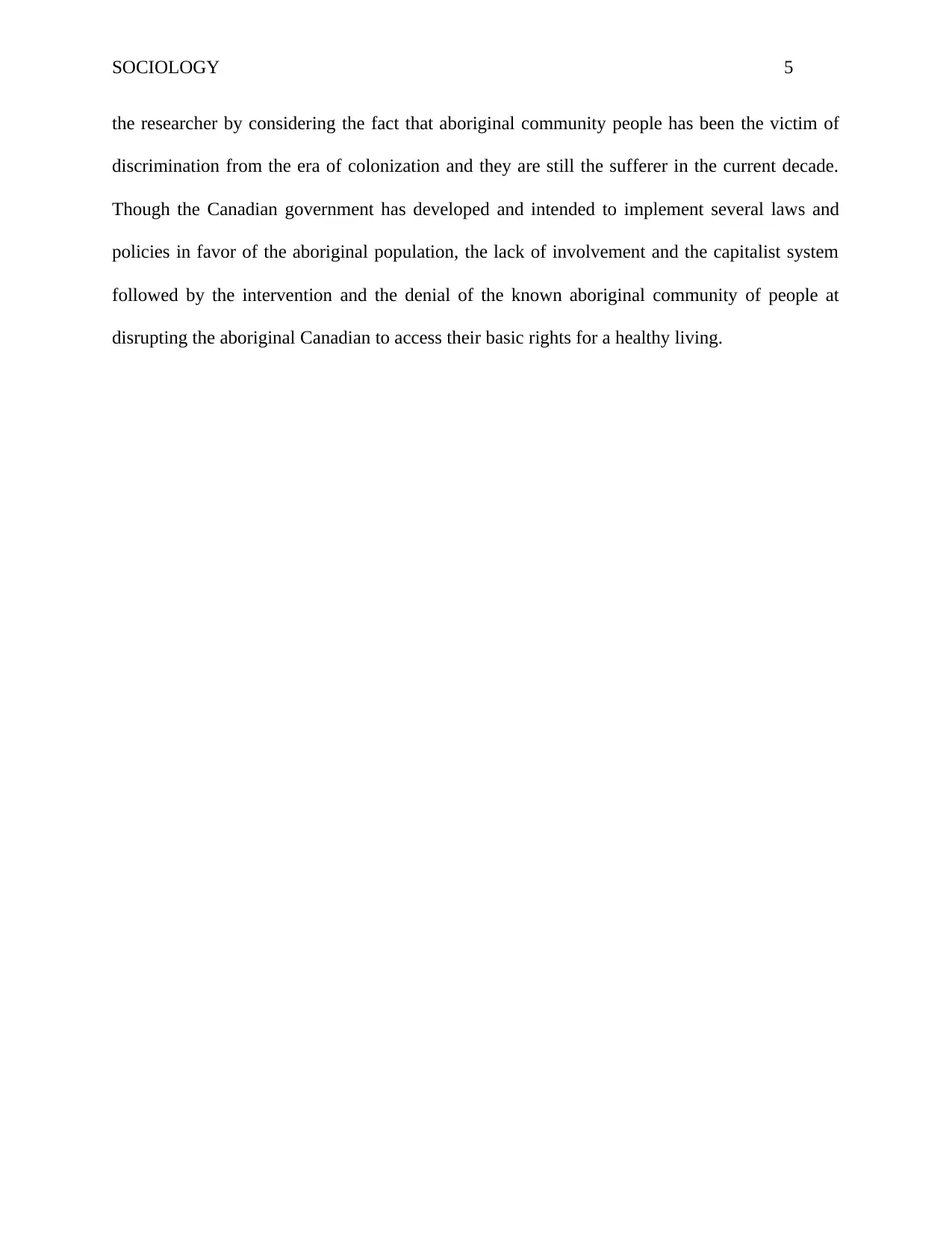
SOCIOLOGY 5
the researcher by considering the fact that aboriginal community people has been the victim of
discrimination from the era of colonization and they are still the sufferer in the current decade.
Though the Canadian government has developed and intended to implement several laws and
policies in favor of the aboriginal population, the lack of involvement and the capitalist system
followed by the intervention and the denial of the known aboriginal community of people at
disrupting the aboriginal Canadian to access their basic rights for a healthy living.
the researcher by considering the fact that aboriginal community people has been the victim of
discrimination from the era of colonization and they are still the sufferer in the current decade.
Though the Canadian government has developed and intended to implement several laws and
policies in favor of the aboriginal population, the lack of involvement and the capitalist system
followed by the intervention and the denial of the known aboriginal community of people at
disrupting the aboriginal Canadian to access their basic rights for a healthy living.
⊘ This is a preview!⊘
Do you want full access?
Subscribe today to unlock all pages.

Trusted by 1+ million students worldwide
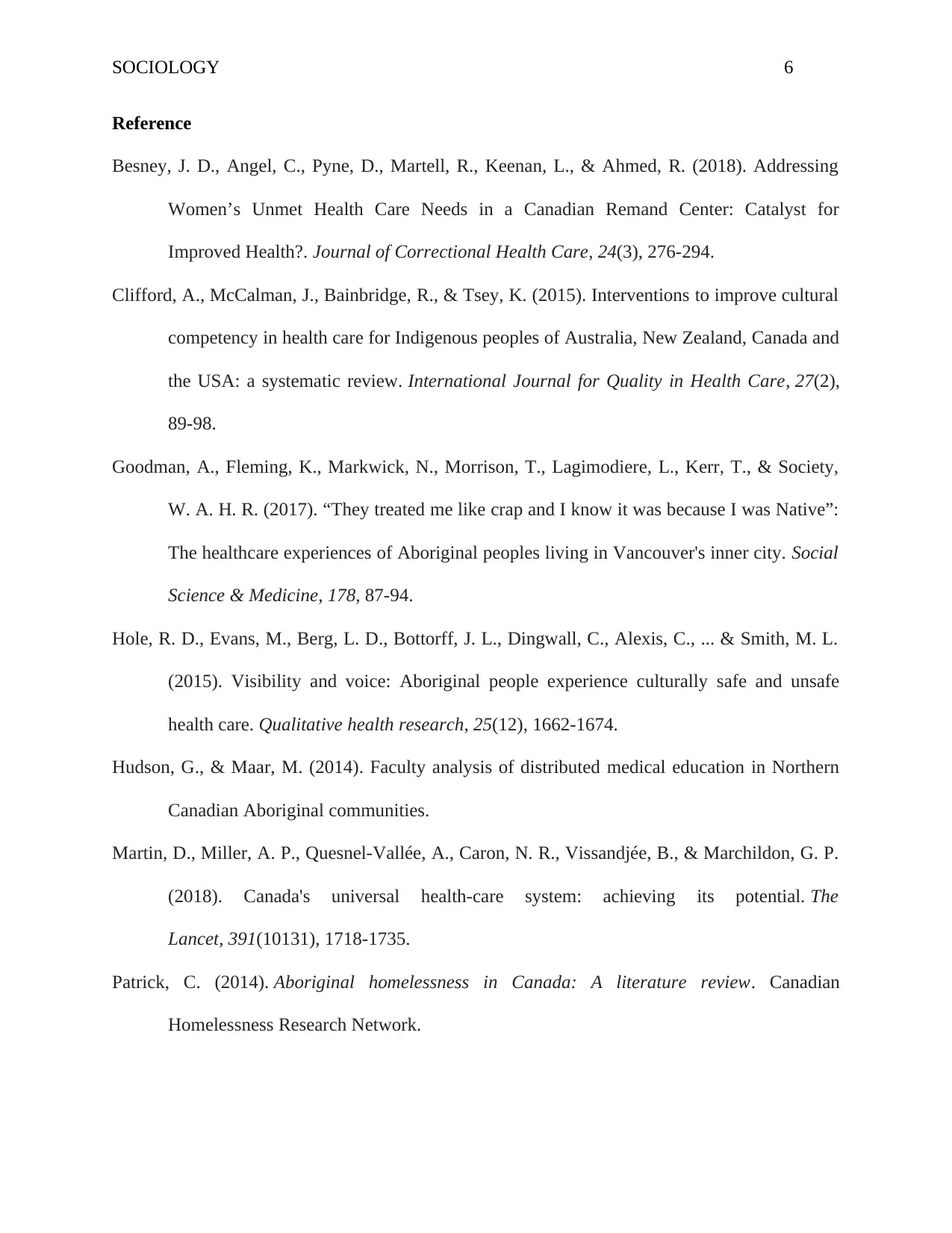
SOCIOLOGY 6
Reference
Besney, J. D., Angel, C., Pyne, D., Martell, R., Keenan, L., & Ahmed, R. (2018). Addressing
Women’s Unmet Health Care Needs in a Canadian Remand Center: Catalyst for
Improved Health?. Journal of Correctional Health Care, 24(3), 276-294.
Clifford, A., McCalman, J., Bainbridge, R., & Tsey, K. (2015). Interventions to improve cultural
competency in health care for Indigenous peoples of Australia, New Zealand, Canada and
the USA: a systematic review. International Journal for Quality in Health Care, 27(2),
89-98.
Goodman, A., Fleming, K., Markwick, N., Morrison, T., Lagimodiere, L., Kerr, T., & Society,
W. A. H. R. (2017). “They treated me like crap and I know it was because I was Native”:
The healthcare experiences of Aboriginal peoples living in Vancouver's inner city. Social
Science & Medicine, 178, 87-94.
Hole, R. D., Evans, M., Berg, L. D., Bottorff, J. L., Dingwall, C., Alexis, C., ... & Smith, M. L.
(2015). Visibility and voice: Aboriginal people experience culturally safe and unsafe
health care. Qualitative health research, 25(12), 1662-1674.
Hudson, G., & Maar, M. (2014). Faculty analysis of distributed medical education in Northern
Canadian Aboriginal communities.
Martin, D., Miller, A. P., Quesnel-Vallée, A., Caron, N. R., Vissandjée, B., & Marchildon, G. P.
(2018). Canada's universal health-care system: achieving its potential. The
Lancet, 391(10131), 1718-1735.
Patrick, C. (2014). Aboriginal homelessness in Canada: A literature review. Canadian
Homelessness Research Network.
Reference
Besney, J. D., Angel, C., Pyne, D., Martell, R., Keenan, L., & Ahmed, R. (2018). Addressing
Women’s Unmet Health Care Needs in a Canadian Remand Center: Catalyst for
Improved Health?. Journal of Correctional Health Care, 24(3), 276-294.
Clifford, A., McCalman, J., Bainbridge, R., & Tsey, K. (2015). Interventions to improve cultural
competency in health care for Indigenous peoples of Australia, New Zealand, Canada and
the USA: a systematic review. International Journal for Quality in Health Care, 27(2),
89-98.
Goodman, A., Fleming, K., Markwick, N., Morrison, T., Lagimodiere, L., Kerr, T., & Society,
W. A. H. R. (2017). “They treated me like crap and I know it was because I was Native”:
The healthcare experiences of Aboriginal peoples living in Vancouver's inner city. Social
Science & Medicine, 178, 87-94.
Hole, R. D., Evans, M., Berg, L. D., Bottorff, J. L., Dingwall, C., Alexis, C., ... & Smith, M. L.
(2015). Visibility and voice: Aboriginal people experience culturally safe and unsafe
health care. Qualitative health research, 25(12), 1662-1674.
Hudson, G., & Maar, M. (2014). Faculty analysis of distributed medical education in Northern
Canadian Aboriginal communities.
Martin, D., Miller, A. P., Quesnel-Vallée, A., Caron, N. R., Vissandjée, B., & Marchildon, G. P.
(2018). Canada's universal health-care system: achieving its potential. The
Lancet, 391(10131), 1718-1735.
Patrick, C. (2014). Aboriginal homelessness in Canada: A literature review. Canadian
Homelessness Research Network.
Paraphrase This Document
Need a fresh take? Get an instant paraphrase of this document with our AI Paraphraser
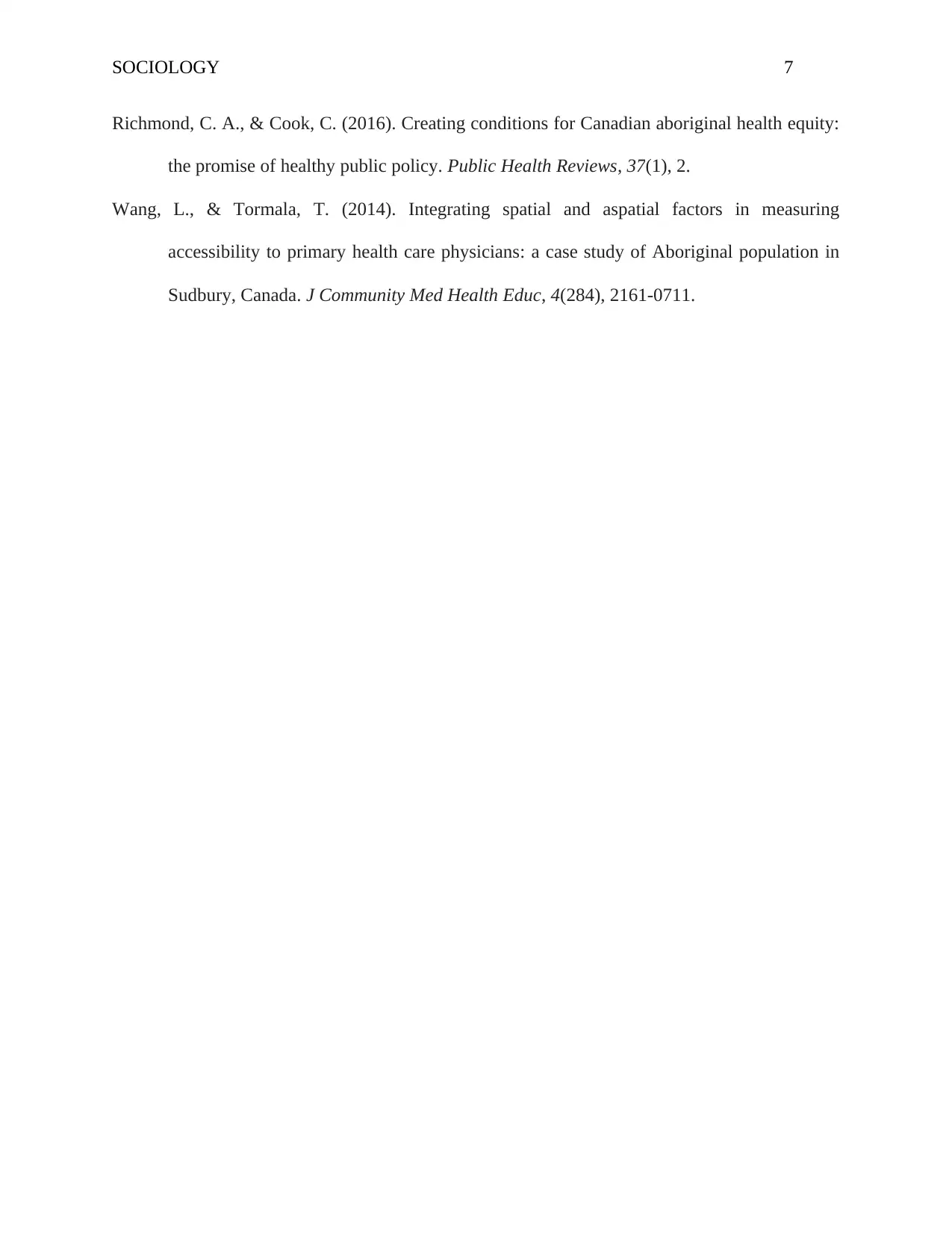
SOCIOLOGY 7
Richmond, C. A., & Cook, C. (2016). Creating conditions for Canadian aboriginal health equity:
the promise of healthy public policy. Public Health Reviews, 37(1), 2.
Wang, L., & Tormala, T. (2014). Integrating spatial and aspatial factors in measuring
accessibility to primary health care physicians: a case study of Aboriginal population in
Sudbury, Canada. J Community Med Health Educ, 4(284), 2161-0711.
Richmond, C. A., & Cook, C. (2016). Creating conditions for Canadian aboriginal health equity:
the promise of healthy public policy. Public Health Reviews, 37(1), 2.
Wang, L., & Tormala, T. (2014). Integrating spatial and aspatial factors in measuring
accessibility to primary health care physicians: a case study of Aboriginal population in
Sudbury, Canada. J Community Med Health Educ, 4(284), 2161-0711.
1 out of 8
Related Documents
Your All-in-One AI-Powered Toolkit for Academic Success.
+13062052269
info@desklib.com
Available 24*7 on WhatsApp / Email
![[object Object]](/_next/static/media/star-bottom.7253800d.svg)
Unlock your academic potential
Copyright © 2020–2025 A2Z Services. All Rights Reserved. Developed and managed by ZUCOL.





